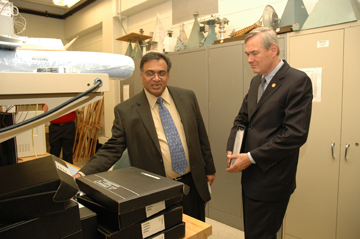Research Center Receives $17.9 million from National Science Foundation
The Center for Remote Sensing of Ice Sheets, headquartered at the University of Kansas, will receive more than $17.9 million from the National Science Foundation to continue its innovative research on the changing conditions of the world’s polar ice.
“Researchers at CReSIS have done a remarkable job of creating new tools that provide unique data about the health of our planet,” said Chancellor Bernadette Gray-Little. “This national grant is confirmation of the pioneering research taking place at KU. Our researchers’ revolutionary work is providing a more complete picture of the potential impact that climate change may have on all of us.”

The renewal award brings the total NSF award amount to $36.9 million, which represents the largest grant ever awarded to support research at KU.
The multi-institutional CReSIS was created in 2005. The five-year renewal award acknowledges the continuing success the center has had in its efforts to create new ice-penetrating radars, vehicles and computer models that can measure the current state and changes in polar ice and then predict the impact on global climate change and sea-level rise. A recent report in Scientific American cites a British economist as saying that 200 million people currently live within 1 meter above sea level, including residents in eight of the 10 largest cities in the world. Moreover, the article also states in the 20th century the oceans rose by about 17 centimeters, and researchers now know that ice sheets are melting at a faster pace than previously thought.
Using a multidisciplinary approach, CReSIS researchers combine expertise in electrical engineering, information technology, aerospace engineering, glaciology and geophysics to develop, test and utilize radars in the field. Measurements and data gathered during missions to Greenland or Antarctica are crucial to the accurate prediction of future sea level rise. The center also has a strong commitment to developing devices that have commercial applications and appeal.
“The faculty, students and staff have developed sensors, Uninhabited Aerial Vehicles and advanced concepts to obtain much needed data on the ice-bed interface at the ice-sheet margins and fast-flowing glaciers, and the renewal is a reflection of the excellent progress made by the center thus far,” said Prasad Gogineni, CReSIS director and the Deane Ackers Distinguished Professor of Electrical Engineering and Computer Science. “The technical and scientific skills represented here are among the best in the world.”

The NSF award also includes outreach efforts designed to encourage K-12 students to pursue careers in science and engineering. CReSIS provides opportunities for undergraduate and graduate students to improve their technical and communication skills and participate in research that involves significant international collaboration.
“The center has been a valuable asset for this university as well as the School of Engineering,” said Stuart Bell, dean of engineering. “Dozens of our students, at both the graduate and undergraduate level, have been able to glean valuable hands-on experience before they advance from this institution. In addition, our students can see their efforts have a very real impact on the world around them.”
Over the past five years, researchers and students at CReSIS have achieved many successes and firsts in their endeavors. In August 2009, after nearly five years of designing and building, the aerial platform research team successfully launched the Meridian Uninhabited Aerial Vehicle on its maiden flight. The Meridian — which has a 26-foot wingspan and is designed to carry a radar payload as it flies exact routes in extreme climates — later went through flight-testing in the field in Antarctica. In January 2010, CReSIS radar developers published findings that provide the first three-dimensional “look” at the topography of Greenland beneath miles of ice. The radars and computer models are so advanced that in 2009, NASA selected these KU-built radars to be a part of the multiyear Operation Ice Bridge, an earth sciences mission that monitors the state and changes of polar ice sheets and sea ice. Two patents have been awarded as a result of work at CReSIS. Fifty-five graduate students — 38 at the master’s degree level and 17 at the doctoral degree level — have earned their degrees while conducting research at the center.
This fall, CReSIS will be one of a select group of research centers and organizations featured in the inaugural USA Science and Engineering Festival and Expo to be held Oct. 10-24 on the National Mall in Washington, D.C.
Partner institutions
Elizabeth City State University, Elizabeth City, N.C.
Pennsylvania State University
The University of Washington
Indiana University
Los Alamos National Laboratory
The Association of Computer/Information Sciences and Engineering Departments at Minority Institutions
Industry and Government partners
NINSA, Honeywell, Kansas City Plant
NASA Goddard Space Flight Center
NASA Jet Propulsion Laboratory
Sprint Corp.
Worldwide collaborators
Antarctic Climate and Ecosystems Cooperative Research Centre, Tasmania, Australia Centre for Ice and Climate, Niels Bohr Institute, University of Copenhagen, Denmark Centre for Polar Observations and Modeling, Cambridge, United Kingdom Indian Institute of Technology, Kanpur, India Technical University of Denmark, Lundtofte, Denmark
The National Science Foundation is an independent federal agency that supports fundamental research and education across all fields of science and engineering. The goals of the Science and Technology Center program include developing an effective means of support for long-term scientific and technological research and education. The program encourages proposals that represent high quality, important investigations at the interface of disciplines.